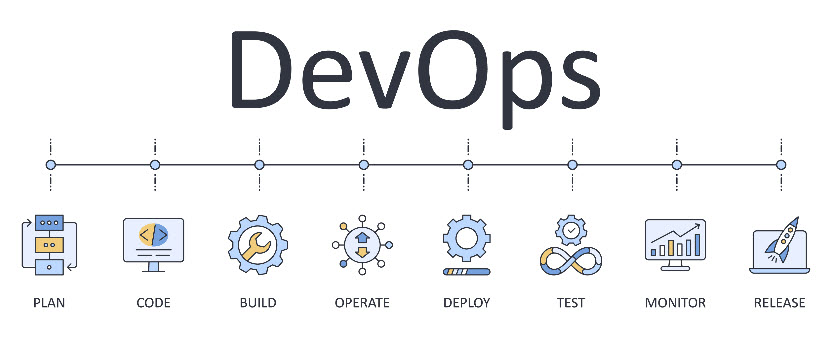DevOps is a combination of two words, development and operations, and represents a paradigm shift in the way organizations handle software development and IT operations. Beyond mere tools and practices, it is a cultural and professional movement that emphasizes robust collaboration, communication, and integration between software developers and IT operations professionals.
Today, every organization is under pressure to innovate fast and provide high-quality software products that meet continuously changing customer needs. DevOps addresses this challenge by building a culture of shared responsibility, continuous improvement, and automation. It bridges the gap between development and operation teams, enabling them to accelerate delivery timelines, improve software quality, and enhance operational efficiency.
This guide covers core DevOps principles, explaining their importance, benefits, challenges, and strategies for implementation.

What Do DevOps Principles Include?
DevOps principles guide practices that enhance collaboration, efficiency, and agility. These principles are interrelated and collectively contribute to the successful adoption of DevOps methodologies.
Here are sixteen DevOps principles:
1. Collaboration and Communication
Effective collaboration and communication are essential for DevOps. Traditionally, development and operations teams work independently, which results in misaligned objectives, delays, and inefficiencies. DevOps addresses this issue by promoting a culture of shared goals and open communication.
This is how you can implement collaboration:
- Cross-functional teams. Form teams that include developers, operations staff, QA testers, and other stakeholders.
- Shared objectives. Align team goals with business objectives to ensure everyone works towards the same outcomes.
- Transparent communication. Use collaboration tools like Slack, Microsoft Teams, or Confluence to enable real-time communication and knowledge sharing.
- Regular meetings. Hold daily stand-ups, sprint reviews, and retrospectives to keep everyone informed and engaged.
By promoting collaboration, organizations reduce misunderstandings, accelerate problem-solving, and encourage innovation through diverse perspectives.
2. Continuous Integration and Continuous Delivery (CI/CD)
Continuous integration and continuous delivery (CI/CD) are practices that automate the integration, testing, and deployment of code changes. This principle ensures that software is always in a releasable state, allowing organizations to respond swiftly to market demands.
Essential components of CI/CD include:
- Continuous integration (CI). Merge code changes into a central repository frequently, triggering automated builds and tests to detect integration issues early.
- Continuous delivery (CD). Extend CI by automating the release process so that code changes can be deployed to production at any time.
- Automated build processes. Use tools like Jenkins to automatically compile code following changes.
- Automated testing. Incorporate unit, integration, and acceptance tests into the DevOps pipeline to validate code quality.
- Deployment automation. Use configuration management tools like Ansible or Puppet to deploy applications consistently across environments.
Check out our article on the top CI/CD tools for sysadmins.
3. Automation
Automation is a fundamental principle of DevOps, aiming to eliminate manual, error-prone tasks and streamline workflows. By automating repetitive processes, organizations enhance efficiency, reduce errors, and ensure consistency across environments.
Areas of automation include:
- Infrastructure provisioning. Use Infrastructure as Code (IaC) tools like Terraform to automate the setup of servers, networks, and other infrastructure components.
- Configuration management. Ensure systems are configured consistently using tools like Chef, Puppet, or Ansible.
- Testing automation. Automate testing processes to quickly validate code changes and detect defects early.
- Deployment automation. Automate the deployment of applications to various environments, reducing deployment time and minimizing human errors.
4. Infrastructure as Code
Infrastructure as Code is the practice of managing and provisioning computing infrastructure through machine-readable definition files rather than physical hardware configuration. This principle enables teams to manage resources more efficiently and ensures consistency across environments. By treating infrastructure as code, organizations reduce configuration drift, improve disaster recovery processes, and facilitate scalable and repeatable infrastructure deployments.
Here are ways to leverage IaC:
- Version control. Store infrastructure code in version control systems like Git, allowing teams to track changes and collaborate effectively.
- Reproducibility. Enable the creation of identical environments, ensuring consistency across development, testing, and production stages.
- Automation. Execute IaC scripts automatically to provision and configure resources, reducing manual effort.
- Common tools. Use tools like Terraform for provisioning across multiple cloud providers or AWS CloudFormation for describing and provisioning infrastructure in AWS environments.
5. Monitoring and Logging
Continuous monitoring and logging are critical for maintaining system health, performance, and security. Monitoring and logging help teams detect anomalies, understand system behaviors, and make data-driven decisions to improve system health and user experience.
Vital components of monitoring and logging include:
- Real-time monitoring. Use tools like Prometheus, Nagios, or Datadog to monitor system metrics, application performance, and user experience.
- Alerting mechanisms. Set up alerts for critical events or threshold breaches to enable immediate response and minimize downtime.
- Centralized logging. Aggregate logs from various sources using tools like ELK Stack (Elasticsearch, Logstash, Kibana) or Splunk for analysis and troubleshooting.
- Analytics and reporting. Generate reports and dashboards to visualize data trends and inform decision-making.
Read our article on the best server monitoring tools available.
6. End-to-End Responsibility
DevOps promotes the idea that teams should own the entire lifecycle of the application, from inception to retirement. End-to-end responsibility fosters accountability, improves quality, and ensures that teams are fully invested in the success of the application.
The responsibilities of teams implementing DevOps include:
- Design and development. Craft software that meets user requirements and adheres to quality standards.
- Deployment and operations. Manage the deployment process and ensure the application runs smoothly in production.
- Maintenance and support. Provide ongoing support, handling incidents, and implementing updates or fixes.
- Decommissioning. Plan for the end-of-life of applications, including data migration or archiving.
7. Continuous Feedback
Incorporating continuous feedback loops is essential for iterative improvement. This principle emphasizes gathering input at every stage to refine processes and products. Continuous feedback enables teams to make data-driven decisions, adapt to changing requirements, and enhance user satisfaction.
Feedback sources include:
- User feedback. Gather input from end-users through surveys, feedback forms, or direct communication to understand their needs and satisfaction levels.
- Automated metrics. Collect data on application performance, usage patterns, and error rates to inform decisions.
- Peer reviews. Conduct code reviews and collaborative evaluations to improve code quality and share knowledge.
- Stakeholder input. Engage with business stakeholders to align technical efforts with strategic objectives.
8. Lean and Agile Principles
DevOps integrates lean and agile methodologies to optimize processes and improve responsiveness. This principle focuses on delivering value efficiently and adapting to change quickly.
Implementation approaches include:
- Lean principles. Eliminate waste, optimize workflows, and maximize resource utilization to focus on value creation.
- Agile practices. Employ iterative development cycles (sprints), continuous planning, and adaptability to change.
- Kanban boards. Visualize work in progress and limit work items to improve flow and reduce bottlenecks.
- Scrum framework. Organize work into sprints with defined goals and regular reviews to maintain focus and adaptability.
Combining Agile and DevOps entails integrating the principles and practices of both methodologies. Read our article on DevOps vs. Agile to understand their unique strengths and how they interact.

9. Security Integration (DevSecOps)
Cybersecurity is a critical component of DevOps, leading to the evolution of DevSecOps, where security practices are integrated throughout the software development lifecycle. This principle ensures that applications are protected against various types of cyber attacks and reduces the likelihood of costly data breaches or reputational damage.
Integration strategies include:
- Shift-left security. Incorporate security checks early in development to identify and mitigate risks quickly.
- Automated security testing. Embed security tests in the CI/CD pipeline using tools like OWASP ZAP or Snyk.
- Security training. Educate developers on secure coding practices and common vulnerabilities to prevent security flaws.
- Compliance automation. Automate compliance checks to adhere to regulatory standards like GDPR, HIPAA, or PCI DSS.
10. Culture of Continuous Improvement
A culture of continuous improvement encourages teams to constantly seek ways to enhance efficiency and quality. This principle drives innovation and keeps the organization competitive in a rapidly evolving industry.
Cultural practices include:
- Learning from failures. Conduct blameless post-mortems to understand the root causes of issues and prevent future occurrences.
- Experimentation and innovation. Encourage experimentation with new technologies or processes to discover better solutions.
- Reflection and adaptability. Regularly review practices and make iterative changes for better outcomes through retrospectives and feedback sessions.
- Knowledge sharing. To build team capabilities, promote knowledge sharing through documentation, workshops, or mentoring.
11. Version Control for All Assets
Using version control systems extends beyond code to include all assets involved in the development and deployment process. The benefits of version control include traceability, collaboration, rollback capabilities, and enhanced security through change history.
Assets to version control include:
- Configuration files. Track changes in system configurations to maintain consistency across environments.
- Scripts and automation code. Version scripts used for automation tasks to ensure reproducibility and collaboration.
- Documentation. Manage documentation versions to keep information up-to-date and accessible.
- Infrastructure definitions. Store IaC scripts in version control for transparency and collaboration.
12. Customer-Centric Approach
Placing the customer at the center of all activities ensures that products meet real needs. This principle involves understanding and prioritizing customer requirements throughout the development process. A customer-centric approach leads to higher satisfaction, better product-market fit, and increased loyalty.
Customer engagement strategies include:
- User research. Conduct interviews, surveys, and usability testing to understand user requirements and pain points.
- Feedback mechanisms. Implement features like in-app feedback, support channels, or community forums to gather real-time input.
- Feature prioritization. Use customer input to prioritize features that deliver the most value and enhance user experience.
- Customer journey mapping. Visualize the end-to-end experience to identify opportunities for improvement and ensure satisfaction.
13. Standardization and Consistency
Establishing standardized processes and tools enhances efficiency and reduces errors. This principle focuses on creating a uniform approach to development and operations. Standardization simplifies onboarding, reduces variability, and improves predictability in outcomes.
Standardization practices include:
- Toolchain standardization. Select a common set of tools for development, testing, deployment, and monitoring to simplify processes.
- Process documentation. Define and document processes to ensure they are followed consistently across teams.
- Environment consistency. To reduce deployment issues, ensure that development, testing, and production environments mirror each other closely.
14. Microservices Architecture
A microservices architecture involves designing applications as a suite of small, independent services. This principle allows for greater flexibility and scalability in application development and deployment. Implementing microservices requires careful planning around service boundaries, communication protocols, and orchestration tools.
Advantages of microservices include:
- Modularity. Break down applications into discrete components that perform specific functions, making them easier to develop and maintain.
- Independent deployment. Allow services to be developed, tested, and deployed independently, reducing deployment times and risks.
- Scalability. Enable individual services to scale based on demand without affecting the entire application.
- Technology diversity. Permit the use of different technologies or languages best suited for each service, enhancing innovation.
15. Self-Service Configuration
Providing teams with self-service capabilities empowers them to work more efficiently. This principle reduces dependencies and accelerates workflows. Additionally, it increases developer satisfaction and productivity by reducing wait times and bottlenecks.
Self-service capabilities include:
- Provisioning resources. Allow teams to use portals or APIs to request and configure infrastructure or services on-demand.
- Automated deployment. Enable developers to initiate deployments without waiting for centralized approval using predefined templates and scripts.
- Access to tools and services. Provide a catalog of pre-approved tools and services for development and testing purposes.
16. Proactive Failure Detection and Recovery
Anticipating failures and implementing strategies for rapid recovery are essential for maintaining high availability. This principle focuses on building resilient systems that can withstand and quickly recover from failures. By proactively managing failures, organizations enhance user trust and ensure business continuity.
Proactive strategies include:
- Chaos engineering. Intentionally introduce failures to test system resilience and response mechanisms using tools like Chaos Monkey.
- Redundancy and failover. Design systems with redundancy to handle component failures without service disruption.
- Automated recovery. Implement scripts or processes that automatically recover or restart failed services to minimize downtime.
- Disaster recovery planning. Develop and test plans for recovering from major incidents, including data backups and restoration procedures.

What Are the Benefits of DevOps Principles?
Adopting DevOps principles yields substantial benefits across various dimensions, impacting both technical operations and business outcomes.
Accelerated Time to Market
DevOps enables organizations to bring products and features to market faster by streamlining workflows and eliminating bottlenecks. Automation and efficient processes significantly reduce lead times, shortening the duration from code commit to deployment.
This efficiency allows for more frequent releases, keeping products competitive and responsive to market needs. Consequently, organizations can capitalize on opportunities more swiftly than their competitors, gaining a first-mover advantage and securing a strategic edge in the marketplace.
Improved Collaboration and Efficiency
Breaking down barriers between teams promotes a cohesive work environment where collaboration thrives. Teams become more productive through shared goals and reduced friction, enhancing productivity.
Improved collaboration results in better utilization of skills and resources, which translates into cost savings through resource optimization. Moreover, collaborative environments encourage creative problem-solving and advance innovation, contributing to continuous improvement and driving the organization forward.
Higher Quality Software
Continuous testing and integration ensure that code changes are validated early and often, leading to more reliable and robust software. Early defect detection through continuous testing catches issues when they are easier and less costly to fix, preventing them from escalating into more significant problems.
Maintaining consistent environments across development, testing, and production reduces inconsistencies, minimizing deployment issues and defects. Additionally, proactive monitoring and failure testing enhance the robustness of applications, resulting in more resilient systems and stable software performance.
Enhanced Customer Satisfaction
Organizations can deliver updates and new features more frequently, aligning products closely with customer needs and expectations. Quickly addressing customer feedback through responsive updates improves satisfaction and fosters loyalty.
Stable and high-performing applications enhance the user experience and build trust, contributing to reliable performance. Focusing on customer needs ensures that products provide real value, meet expectations, and often exceed them, strengthening the organization's reputation and market position.
Scalability and Flexibility
Automation and infrastructure as code enable organizations to scale resources rapidly in response to changing demands. The ability to scale resources up or down ensures optimal performance and cost-efficiency, offering an elastic infrastructure that adapts to varying workloads. This adaptability allows organizations to pivot or adjust strategies quickly in response to market changes or evolving customer needs, maintaining competitiveness and relevance.
Reduced Costs
Efficiency gains from automation, improved collaboration, and optimized resource utilization result in significant cost savings. Automation reduces manual labor and associated expenses, enhancing operational efficiency.
By reducing errors through automated processes, organizations save on rework, downtime, and support costs. Optimized use of infrastructure minimizes wasteful expenditure and overhead, improving overall resource utilization and contributing to a healthier bottom line.
Better Risk Management
Proactive monitoring, integrated security practices, and continuous feedback loops lead to the early detection of vulnerabilities, reducing the risk of breaches and compliance issues. Automated compliance checks ensure adherence to regulations, avoiding penalties and providing assurance of compliance. Proactive failure management reduces the impact of incidents and enhances system stability, contributing to organizational resilience and continuity.
Innovation and Competitive Advantage
Freeing teams from manual, repetitive tasks through automation creates an environment conducive to innovation. Teams can focus on higher-value activities, allowing them to test new ideas rapidly and accelerate product development. This capacity for faster experimentation enables organizations to adapt quickly to market trends and customer needs, keeping them ahead of competitors.
Improved Employee Satisfaction
A collaborative culture that values automation and continuous improvement leads to higher job satisfaction among team members. Empowering employees through self-service capabilities and autonomy increases motivation and engagement, as they have greater control over their work.
Opportunities to learn new skills, participate in innovative projects, and contribute meaningfully boost morale and improve employee retention. This focus on professional growth and development benefits the employees and strengthens the organization by retaining top talent.
Enhanced Compliance and Auditability
Automated processes and version-controlled configurations provide clear audit trails and comprehensive documentation, simplifying compliance efforts. By maintaining detailed records and utilizing version control, organizations support auditing processes and ensure regulatory compliance. Automated checks consistently enforce adherence to internal policies and external regulations, strengthening policy enforcement and reducing the risk of non-compliance.

How to Implement DevOps Principles?
Implementing DevOps involves the following key steps:
- Assess current state. Evaluate existing workflows, communication channels, and tools to identify inefficiencies and areas for improvement.
- Define goals. Set clear, measurable objectives aligned with business strategy, such as reducing deployment times or improving team collaboration.
- Build cross-functional teams. Form collaborative teams that include developers, operations staff, QA testers, and cybersecurity experts to work together on projects.
- Implement CI/CD pipelines. Automate code building, testing, and deployment to ensure seamless integration and delivery.
- Automate infrastructure provisioning. Use IaC tools to automate setup and maintain consistency across environments.
- Integrate monitoring and logging. Deploy monitoring tools like Prometheus and Grafana and centralized logging solutions like the ELK Stack for real-time visibility and analysis.
- Adopt a culture of continuous improvement. Encourage regular reviews, retrospectives, and feedback loops to refine processes and promote adaptability.
- Implement security practices. Incorporate automated security testing, regular assessments, and security checkpoints into the development workflow.
- Train and educate teams. Provide training programs, workshops, and resources to ensure team members have the necessary skills and promote continuous learning.
Read our in-depth article on DevOps implementation to learn how to leverage DevOps successfully.

What Do DevOps Principles Not Include?
Understanding what DevOps principles do not include helps prevent misapplication. Exclusions include:
- Rigid hierarchies and silos. DevOps rejects strict separations that hinder collaboration, emphasizing cross-functional teamwork instead.
- Manual, repetitive processes. Reliance on manual tasks that can be automated is contrary to DevOps efficiency goals.
- Security as an afterthought. Treating security as an afterthought undermines system integrity; DevOps integrates security from the outset.
- Generic solutions. Applying one-size-fits-all solutions without considering specific organizational needs is not aligned with DevOps principles.
- Neglecting documentation. While promoting speed, DevOps does not support neglecting documentation, which is essential for knowledge sharing and compliance.
- Ignoring stakeholder engagement. Excluding key stakeholders from processes is contrary to DevOps, which values collaboration and alignment with business objectives.
- Resistance to change. DevOps embraces change and continuous improvement rather than maintaining the status quo.
- Short-term focus. It promotes sustainable practices and long-term success, not just quick fixes.
Are you interested in becoming a DevOps specialist?
Check out our DevOps roadmap, which outlines everything you must know to be successful in a DevOps role.
What Are the Challenges of Implementing DevOps Principles?
DevOps presents challenges organizations must navigate.
Cultural Resistance
Changing established practices and mindsets is often met with resistance from team members accustomed to traditional methods. Overcoming this resistance involves:
- Effective communication. Clearly explain the benefits and involve employees in the transformation process.
- Leadership support. Leaders should model desired behaviors and support teams through the transition.
- Training and support. Provide resources to help employees adapt to new ways of working.
Skill Gaps and Training Needs
Implementing DevOps may reveal gaps in the skills required to effectively utilize new tools and practices. Addressing these gaps includes:
- Assessing competencies. Identify areas where training is needed.
- Investing in education. Provide training programs and encourage certification.
- Hiring experts. Consider bringing in external experts or consultants to fill critical gaps.
Check out our article on the essential DevOps roles and responsibilities to learn who you need to hire and what to account for to create an efficient DevOps team.
Tool Integration Complexity
Selecting and integrating the right set of tools is complex, with potential compatibility and interoperability issues. Mitigation strategies include:
- Careful planning. Research and evaluate tools thoroughly before adoption.
- Pilot programs. Test integrations in a controlled environment.
- Vendor support. Leverage vendor expertise and support services.
Read our list of the best DevOps tools on the market right now.
Managing Legacy Systems
Legacy systems may not readily support automation, integration, or modern deployment practices. Solutions for dealing with legacy systems include:
- Incremental modernization. Gradually update systems to reduce disruption.
- Wrappers and adapters. Use middleware to integrate legacy systems with new tools.
- Strategic replacement. Plan for long-term replacement where necessary.
Defining Metrics and Measuring Success
Identifying appropriate metrics to assess the impact of DevOps initiatives is challenging. Here are some best practices to follow:
- Align metrics with goals. Ensure KPIs reflect business objectives.
- Use leading indicators. Focus on metrics that predict future performance, such as deployment frequency or lead time.
- Continuously review. Regularly assess metrics for relevance and adjust as needed.
Key performance indicators (KPIs) are an effective way to measure goals.
Read our DevOps metrics and KPIs article to learn which metrics are worth tracking.
Security and Compliance Challenges
Integrating security and compliance into fast-paced development cycles is difficult. Use these tactics to mitigate this challenge:
- Automate checks. Use tools to integrate security and compliance into the CI/CD pipeline.
- Collaborate with security teams. Involve security experts early in the development process.
- Educate teams. Train developers on security best practices.
Resource Constraints
Implementing DevOps practices requires significant investment in tools, infrastructure, and training. Here are some resource management strategies:
- Demonstrate ROI. Build a business case highlighting long-term benefits and cost savings.
- Prioritize investments. Focus on high-impact areas first.
- Seek efficiency. Leverage open-source tools where appropriate.
Organizational Silos and Communication Barriers
Traditional organizational structures reinforce silos that make collaboration difficult. Breaking down silos involves these strategies:
- Restructure teams. Organize around products or services rather than functions.
- Promote open communication. Use collaboration tools and encourage transparency.
- Create leadership initiatives. Leaders must encourage and model cross-department collaboration.
Maintaining Momentum and Continuous Improvement
Sustaining the initial momentum of DevOps adoption becomes difficult over time. Efforts to maintain momentum include the following:
- Set milestones. Establish short-term goals to maintain focus.
- Promote regular feedback. Use feedback loops to keep teams engaged and informed.
- Recognize achievements. Celebrate successes to motivate continued effort.
Aligning DevOps with Business Objectives
Ensuring that DevOps initiatives are in harmony with the organization's overarching business goals is crucial for maximizing their value. Alignment strategies include:
- Strategic planning. Integrate DevOps efforts into the organization's strategic planning to support broader business goals.
- Stakeholder engagement. Engage business leaders and stakeholders in technical initiatives to promote a shared understanding of goals and challenges.
- Measure business impact. Establish metrics that reflect business outcomes, such as revenue growth, customer satisfaction, or market position, to demonstrate how DevOps contributes to organizational success.
phoenixNAP embraced DevOps and never looked back. Read our CEO’s article to find out why we did it, the steps we took, and what we gained.

Embracing DevOps Principles for Organizational Transformation
Embracing core DevOps principles requires embracing change on an organizational level and acknowledging that adaptability is key in a competitive market. It is a commitment to breaking free from traditional constraints and cultivating a philosophy that values collaboration, innovation, and efficiency.
By fully committing to this transformation, your organization will position itself to meet the demands of today and shape the future, driving progress and setting new standards of excellence.



